-

Figure 1.
Agrobacterium-mediated transient GUS expression in the citrus epicotyl explants. (a) Histochemical staining of GUS activity in dark-grown citrus epicotyl explants at 2, 3, 4, 5, and 6 d post Agrobacterium infection (dpi). The blue color indicates the transient and stable expression of the GUS reporter gene. (b) The explants infected with Agrobacterium in the same way as in (a) were transferred to a selection medium containing timentin and hygromycin for an additional 5 d. The differences in GUS activity (blue color) between (a) and (b) are indicative of Agrobacterium-mediated transient expression of the GUS gene.
-
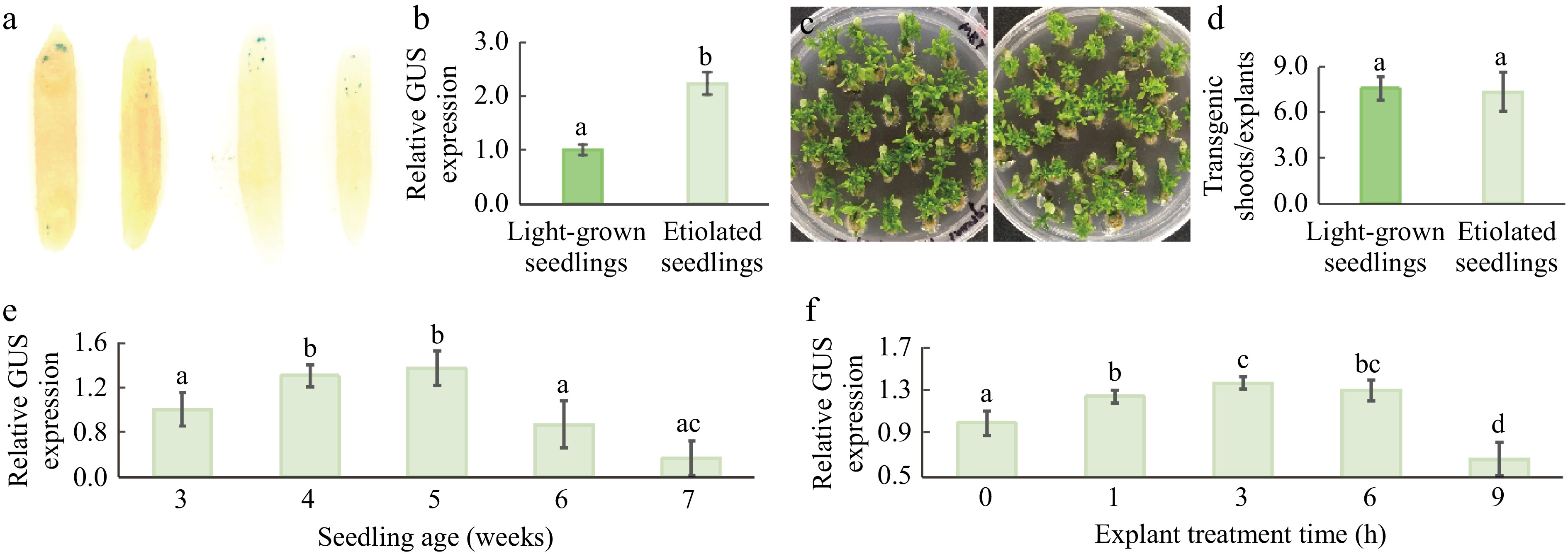
Figure 2.
Effects of growth conditions and seedling age on transient GUS expression. (a) Differential GUS expression in the infected 4-week-old etiolated (two epicotyl explants on the right) and light-grown (two epicotyl explants on the left) tissues. (b) Quantitative analysis of GUS activity in the infected 4-week-old etiolated and light-grown tissues. (c) Transgenic shoot regeneration from the infected etiolated (right panel) and light-grown (left panel) epicotyl explants. (d) Transgenic shoot regeneration efficiency of the infected etiolated and light-grown tissues. (e) Effects of seedling age on GUS gene expression. (f) Effects of duration of hormone treatments of explants on transient GUS expression. The explants were treated in a medium containing 3 mg/L 6-BA, 1 mg/L 2,4-D, and 0.1 mg/L NAA for 0, 1, 3, 6, and 9 h prior to Agrobacterium infection, respectively. Data were averaged from three independent transformation replicates, with ± SD. Significance among treatments is indicated by different lowercase letters (p < 0.05, ANOVA/LSD).
-
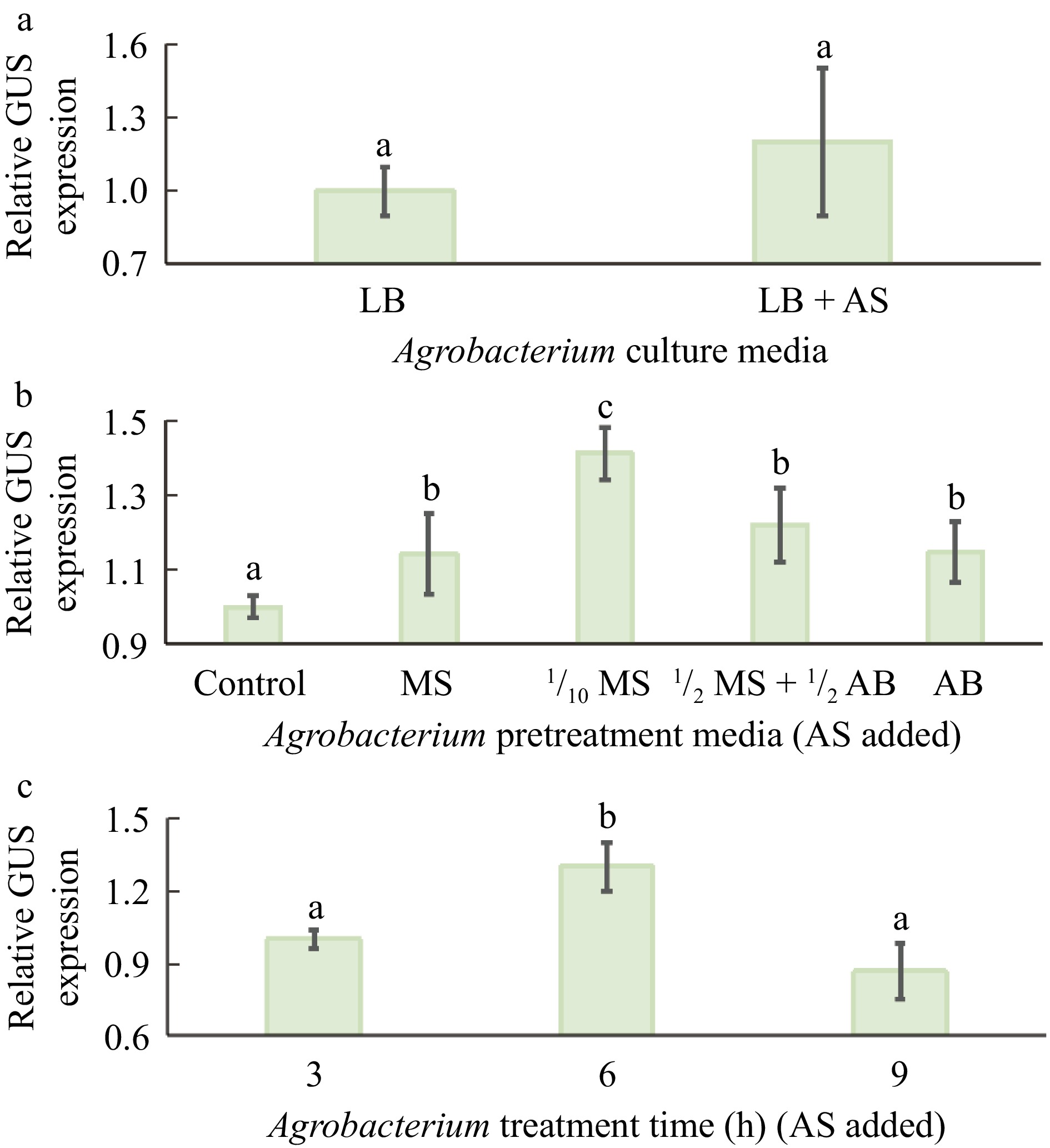
Figure 3.
Effects of components of Agrobacterium cells with acetosyringone (AS) and MS media on Agrobacterium-mediated transient GUS expression. (a) Addition of 20 mg/L AS to the Agrobacterium culture medium, LB medium (pH 7.0). (b) Effects of MS media and Agrobacterium basal (AB) medium on transient GUS gene expression. The duration of the pretreatments of Agrobacterium cells was 3 h. The control was with no pretreatments. (c) Effect of incubation time of Agrobacterium cells in 1/10 MS medium on transient GUS expression. In all experiments, the transient GUS expression activities in the controls were normalized to 1. Different lowercase letters indicate significant differences among different treatments (p < 0.05, ANOVA/LSD).
-
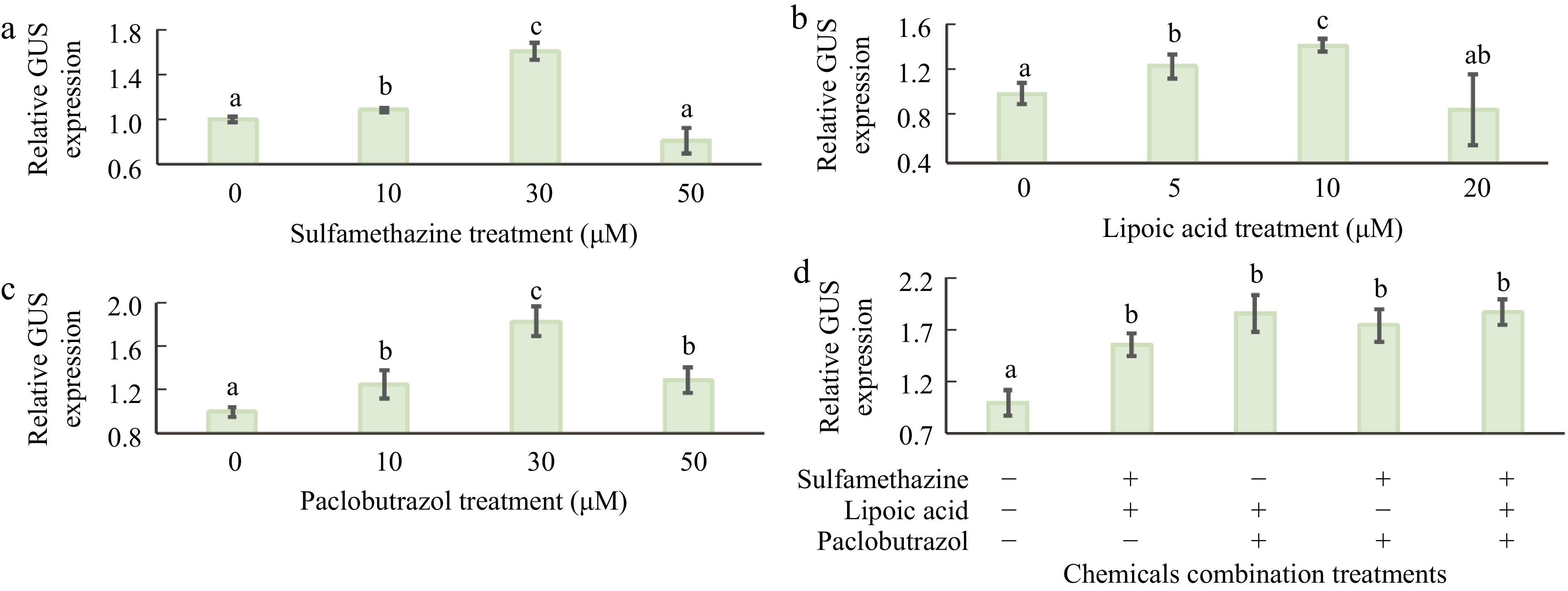
Figure 4.
Effects of chemical treatments added to the co-cultivation media on transient GUS expression. (a) Transient GUS expression in response to sulfamethazine (SMZ). (b) Transient GUS expression in response to lipoic acid (LA). (c) Transient GUS expression in response to paclobutrazol (PBZ). (d) Combined effects of the three chemicals in the co-cultivation medium on transient GUS expression. Experiments were conducted using 4-week-old etiolated seedling explants treated with 3 mg/L 6-BA, 1 mg/L 2,4-D, and 0.1 mg/L NAA for 3 h before infection. Agrobacterium cells were resuspended in 1/10 MS medium (pH 5.8) containing 20 mg/L AS and incubated for 6 h prior to use for infection. Transient GUS expression activity, with no added chemicals in the co-cultivation medium, was normalized to 1. + indicates inclusion of the chemical, while − indicates exclusion. The combination of two of the chemicals (SMZ, LA, and PBZ) can enhance transient GUS expression activity similarly to the effects of all three combined. Different lowercase letters indicate significant differences among different treatments (p < 0.05, ANOVA/LSD).
-
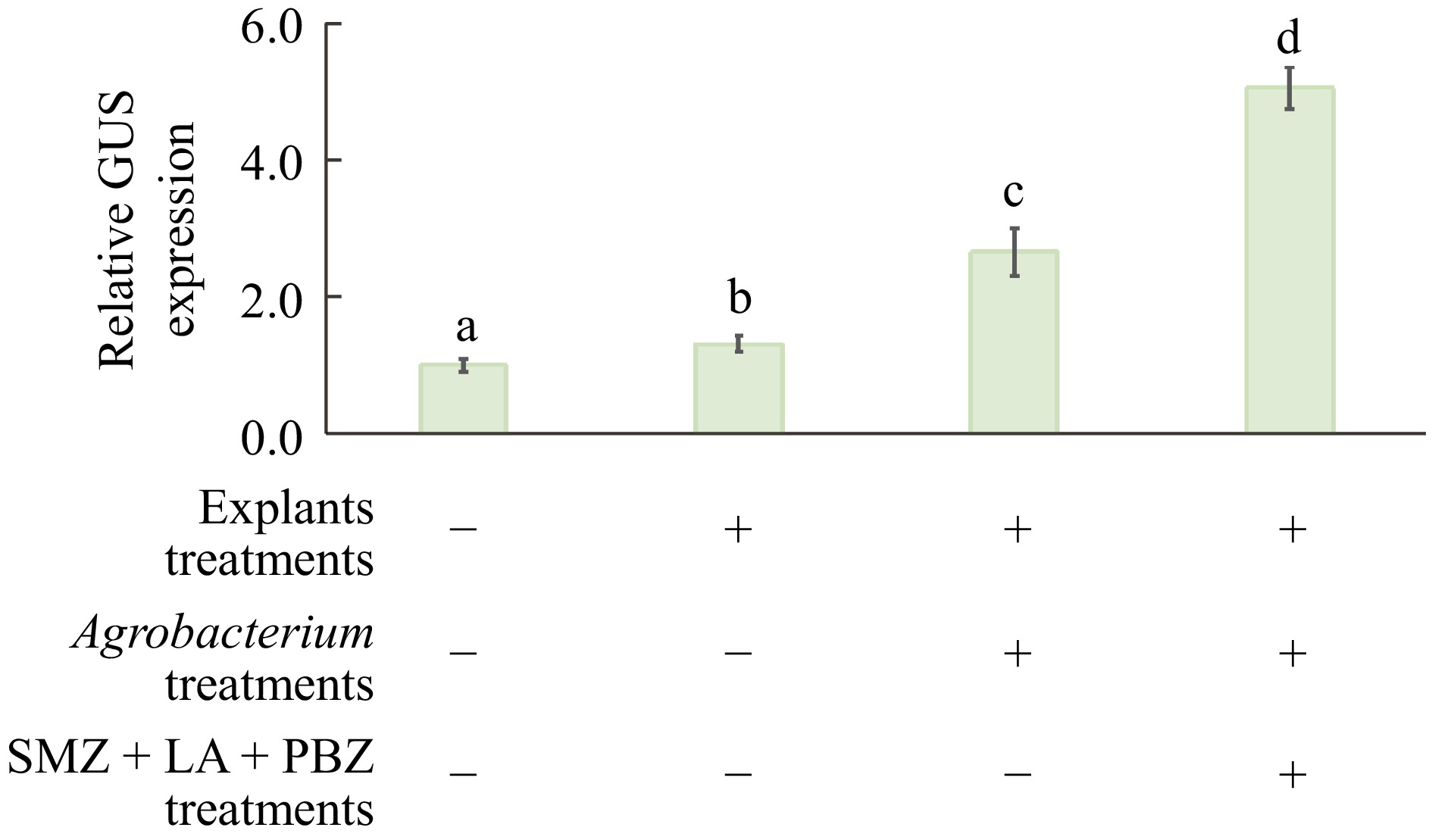
Figure 5.
Combined effects of treatments for Agrobacterium and explants on Agrobacterium-mediated transient GUS expression in citrus epicotyl segments. Expression levels for all other treatments are presented as fold changes compared to the control group. Transient GUS expression activity in the control group (no treatments) was normalized to 1. + or − indicate the inclusion or exclusion of these treatments, respectively. Different lowercase letters indicate significant differences among different treatments (p < 0.05, ANOVA/LSD).
-

Figure 6.
Combined effects of pretreatments of Agrobacterium and explants on Agrobacterium-mediated transient GUS expression in mature citrus stem tissues. Histochemical staining and quantitative analysis of GUS activities were performed on various treatments in (a) Pineapple sweat orange, (b) Valencia orange, and (c) Washington navel orange. Explant treatment, 6-month-old newly grafted mature stem explants were soaked in a hormone-rich medium containing 3 mg/L 6-BA, 1 mg/L 2,4-D, and 0.1 mg/L NAA for 3 h before infection. Agrobacterium cell treatment, Agrobacterium cells were resuspended in a medium (pH 5.8) containing 1/10 MS and 20 mg/L AS and cultured for additional 6 h before infection. The control refers to the Agrobacterium-mediated mature citrus transformation method described by Orbović et al.[31]. This method utilizes 6-month-old newly developed stem explants from grafted mature buds that are immediately infected with Agrobacterium cells resuspended in an infection medium (pH 5.8) containing MS, 100 mg/L myo-inositol, 10 mg/L thiamine-HCl, 10 mg/L pyridoxine-HCl, 1 mg/L nicotinic acid, 2 mg/L glycine, and 30 g/L sucrose. Transient GUS expression activity in the control was normalized to 1. Different lowecase letters indicate significant differences among different treatments (p < 0.05, ANOVA/LSD).
-
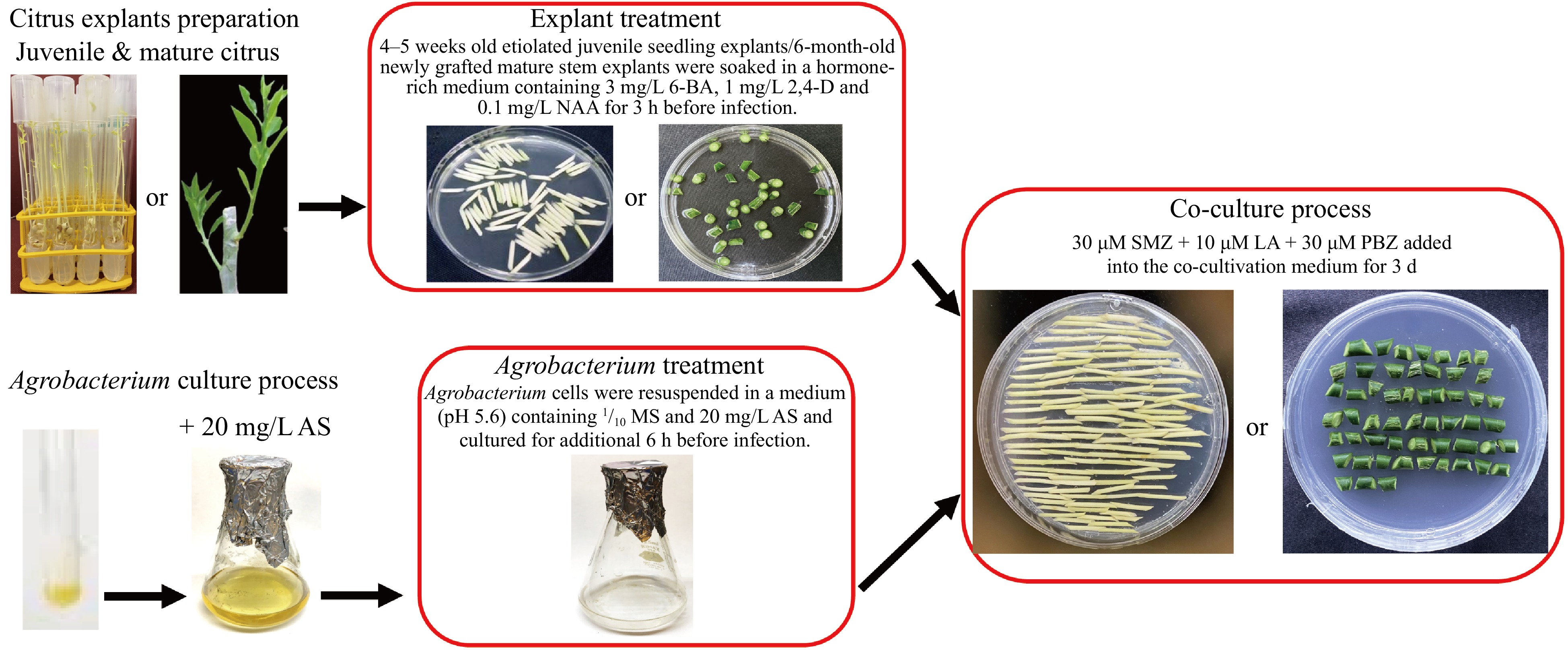
Figure 7.
A summary of the procedure for enhancing Agrobacterium-mediated transient gene expression for both juvenile epicotyl and mature stem tissues of citrus described in this manuscript. The treatments described within the red boxes were incorporated into a conventional procedure for Agrobacterium-mediated infection of both juvenile and mature tissues. The procedure includes treatment of citrus explants and Agrobacterium cells prior to the Agrobacterium-explant co-cultivation, and inclusion of SMZ, LA, and PBZ in co-cultivation medium.
Figures
(7)
Tables
(0)